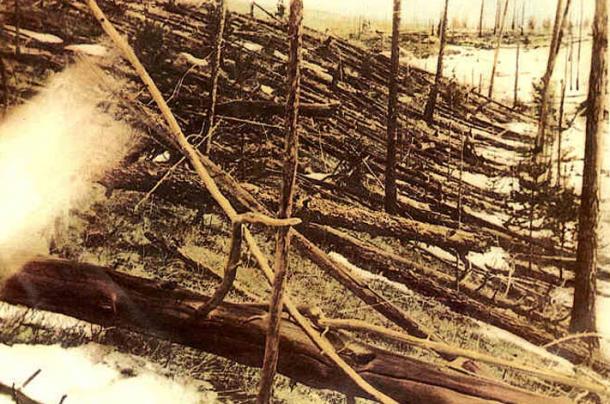
Posted on 07/01/2021 11:16:41 AM PDT by Red Badger
Asteroid Day this year, June 30, 2021, is 113 years after the Tunguska impact event in Siberia, which destroyed an area of pristine forest the size of Tokyo. With blasted and burnt tree trunks leveled and stripped bare over such a vast area, it is as though a large atomic bomb had been dropped on the forest.
The debate still goes on in the research literature, but a popular theory is that this impact was caused by a small comet fragment, in the region of 328 feet (100 meters) in diameter, that exploded at an altitude of around 5 miles (8 kilometers). Its immense downward momentum caused the resulting fireball to target the forest below, like a great blast of dragon breath. No crater was formed, and due to its remote location, it’s thought nobody was actually killed.

Tunguska meteoroid impact, a fraction of the Younger Dryas event. Trees were knocked down and burned over hundreds of square kilometres. (Vizu / Public Domain )
The date of the impact and its apparent direction of travel suggest it was likely caused by a chunk of comet originating from the Taurid meteor stream, the largest meteor stream seen from Earth. The impact energy has been inferred from seismic records at the time of the explosive event as well as computer simulations of the air burst and resulting damage on the ground. At around 5 to 15 megatons of TNT, the magnitude of the Tunguska explosion is often compared to 1000 Hiroshima bombs.
\ Collision with a larger comet, say 0.6 miles (1 kilometer) in diameter, would have generated an explosion around 1000 times larger again, i.e. 1 million Hiroshima bombs. It’s hard to imagine the scale of such an event, but this is the kind of energy scale that has been proposed for the Younger Dryas impact event.
A new paper by Dr. Martin Sweatman of the University of Edinburgh's School of Engineering has just been published in the journal Earth-Science Reviews . It reviews the impact evidence for the Younger Dryas event and covers several of the topics discussed below in more detail.
Ancient Fears to Keep You Up at Night - The End Really, Really is Nigh Planet X – Is there Scientific Evidence? Myths and Meteors: How Ancient Cultures Explained Comets and Other Chunks of Rock Falling From the Sky
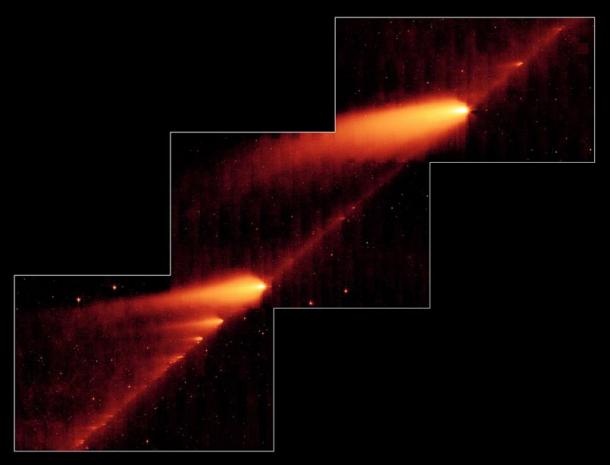
This infrared image from NASA's Spitzer Space Telescope shows the broken Comet 73P/Schwassman-Wachmann 3 skimming along a trail of debris left during its multiple trips around the sun. The flame-like objects are the comet's fragments and their tails, while the dusty comet trail is the line bridging the fragments. (Vesta~commonswiki / Public Domain )
When Did the Younger Dryas Event Occur? The Younger Dryas impact is thought to have occurred between 10,800 to 10,900 BC. Again, it might have been caused by the Taurid meteor stream , although this time the general view is that we collided with a swarm of comet debris, rather than a single object. The impact was so devastating and covered such a wide area, that it is thought to be responsible for an entire geological age (a mini ice-age lasting 1,300 years) known as the Younger Dryas period when temperatures in the northern hemisphere were 27 degrees Fahrenheit (15 degrees Celsius) lower than they are today.
The event caused the extinction of many large animals, especially in the Americas, such as the mastodon and sabre-tooth tiger. Quite possibly, many of today’s well-known myths and religions, including Ragnarok and Christianity, derive originally from a comet-cult inspired by this event. It could hardly be a more important topic.
The Debate on Younger Dryas The research debate surrounding this impact event has been very contentious. Supporters of pre-existing theories for the demise of the American megafauna and the occurrence of the Younger Dryas mini ice age have, naturally, been highly critical of this recent interloper into their long-standing stalemate.
But ultimately, it is not evidence of large animal extinctions or rapid climate change that determine whether a cosmic impact event occurred at this time, as these effects are not diagnostic for such events. That is, these effects can also be generated by other mechanisms. To discover whether a cosmic impact occurred at the beginning of the Younger Dryas period, or the YD ‘boundary’ as it is known, we should instead consider the geochemical evidence, which consists of unusual chemicals or materials generated by the impact remaining in the ground, as this is diagnostic.
Normally, a large asteroidal impact will leave a crater, even if the impact occurs into an ocean – the crater will be in the sea bed in this case. No crater has yet been confirmed for the YD event, although one, and perhaps two, geologically young but very large impact craters under the Greenland ice sheet, discovered only in the last few years, appear to be good candidates.
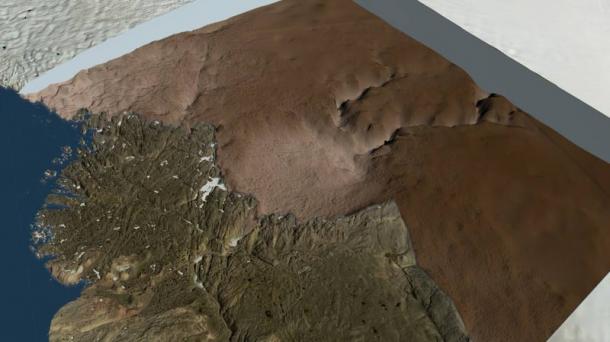
An image from NASA showing the ice sheet removed in the region around the Hiawatha Glacier and the bed topography under the ice clearly showing the Hiawatha crater. (Prokaryotes / Public Domain )
Nevertheless, because the ages of these craters are not yet established, we should instead consider the kind of geochemical signals left behind by Tunguska-like air-bursts at the YD boundary. In fact, many types of exotic material, potentially of impact origin, have been found at this boundary, which appears as a conspicuous band of discolored sediment, or ‘black mat’, at many sites across North America and beyond. Arguably, the three most convincing types of evidence are an abundance of iridium-enriched magnetic grains, nanodiamonds, and high levels of platinum group metals, such as platinum itself or iridium, at the base of the YD black mat.
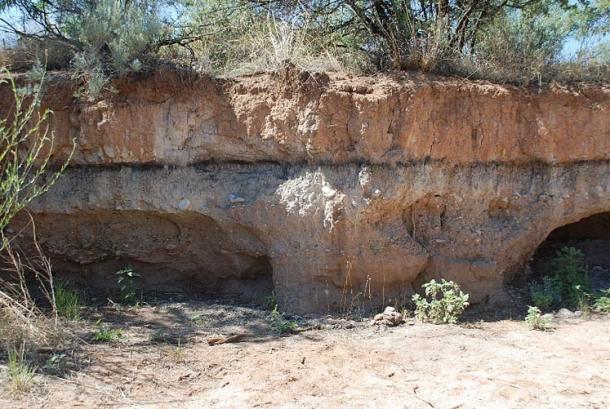
The Younger Dryas boundary lies at the base of the YD black mat. (Comet Research Group / Author Provided)
Magnetic grains, often too small to see with the naked eye, can be formed from iron, common in asteroids and comets, vaporizing at very high temperature, in a massive explosion for example, and then condensing into microscopic magnetic iron droplets, like water condensing as rain. If formed within a cometary air-bust they would be flung through the atmosphere for great distances, creating a carpet or layer of fine magnetic grains over a large expanse of Earth’s surface. Therefore, a sudden large peak, or abundance, in a layer of sediment of iridium-enriched magnetic grains is a good indicator of a cosmic impact, since other sources should be relatively constant over time.
Likewise, nanodiamonds are thought to form within carbon-rich droplets condensing from vaporized carbon generated by a high-temperature and pressure explosion. Asteroids and comets can be rich in carbon, and a cosmic impact might create the conditions required for the formation of carbon droplets containing nanodiamonds. Alternatively, nanodiamonds are common within some asteroids and comets, which means an impact event would simply distribute them over a large patch of Earth’s surface. Therefore, a sudden large peak in nanodiamonds within sediments also very likely indicates a comet or asteroid strike.
The Comet that Sparked a Worldwide Flood ‘Myth’ Did a Comet Destroy Ancient Sardinia? Prehistory Decoded at Gobekli Tepe: From a Cataclysmic Event Dawns the Origin and Perhaps the End of Civilization
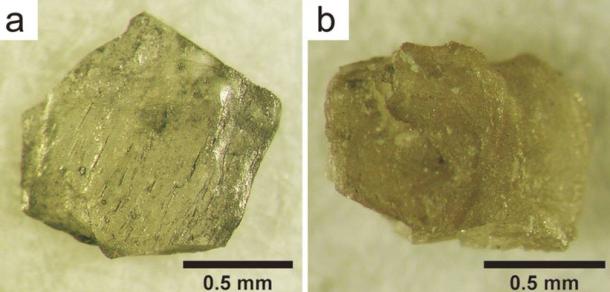
Nanodiamond aggregates from the Popigai crater, Siberia, Russia. a) is composed purely of diamond. b) is composed of a mixture of diamond and small amount of lonsdaleite. (Materialscientist / CC BY-SA 4.0 )
Lastly, platinum group metals (like platinum and iridium) are rare in Earth’s crust, but not so rare in asteroids and comets. Therefore, an abundance, or spike, of a platinum group metal within a sediment layer is another very good indicator of a cosmic impact event. This indicator can be spread very widely around the globe carried within fine dust particles created by the impact explosion.
There is really no alternative mechanism for producing a platinum group metal enriched layer of dust over a large patch of Earth’s surface, other than via a cosmic event like a comet impact, especially if it coincides with an abundance of nanodiamonds and magnetic grains. Indeed, an iridium abundance at the dinosaur-ending 66 million year-old Cretaceous-Palaeogene boundary helped to close that debate out.
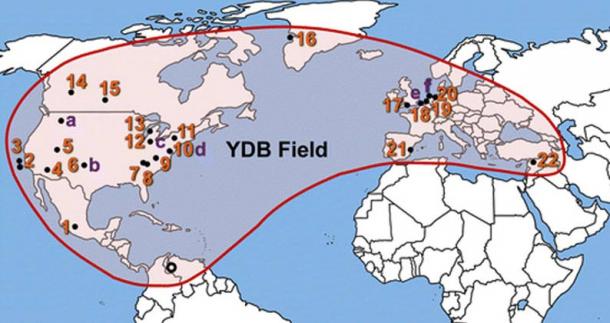
The Younger Dryas boundary (YDB) nanodiamond field. (Comet Research Group / Author Provided)
Each of these lines of geochemical evidence has been found at the YD boundary by the Comet Research Group and later confirmed by several independent research groups. Independent verification of the evidence, by research groups unconnected with the Comet Research Group, is crucial. It means the evidence is real and not mistaken. If other researchers could not find these signals, and there were some negative reports initially, they must have been doing something wrong.
This boundary layer of strange chemicals, which was most likely produced by a swarm of comet debris, has been found spanning three continents. According to the latest research, the debris field now extends to the tip of South America, and to the Near East where we find the world’s earliest megalithic monument – Gobekli Tepe in southern Turkey. Incredibly, the Younger Dryas impact seems to have been recorded there via an early form of proto-writing on its giant stone pillars, and probably inspired its construction.
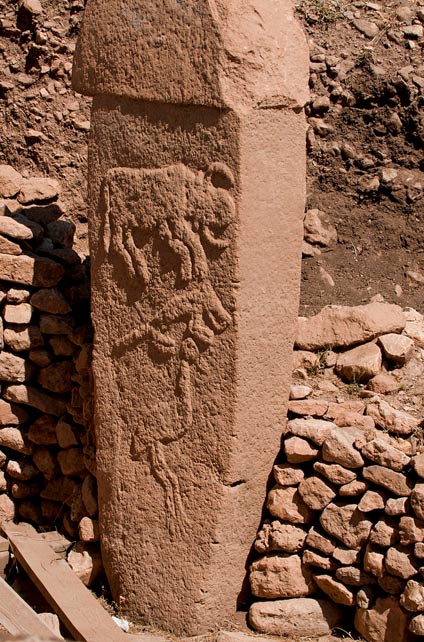
Pillar 2 at Gobekli Tepe, likely describing the path of the radiant of Taurid meteor stream circa 10,000 BC. (Teomancimit / CC BY-SA 3.0 )
One of the clearest geochemical signals of the impact is recorded in a Greenland ice core, which displays a substantial platinum anomaly precisely at the beginning of the Younger Dryas cold period (corresponding to when the oxygen isotope trace, a proxy for temperature plummets). This suggests that this mini ice-age was, very likely, triggered by a cosmic impact. The ice-core date of 12,890 cal BP for this event translates to a calibrated date of around 10,870 BC in real terms.
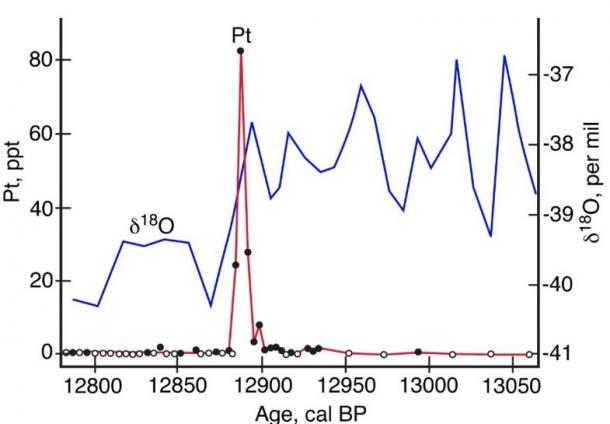
Platinum anomaly (red, left axis) and oxygen isotope trace (blue, right axis) in the GISP2 Greenland ice core. (PNAS / Author Provided)
Despite all the evidence in its favor, the Younger Dryas impact theory has been attacked many times by other researchers desperate to see it repudiated. Initial attempts at refuting it focused on the difficulty of reproducing the geochemical data. But, as has been said, these signals found across several continents have now been confirmed by multiple independent research groups. After this clarification, its opponents accepted the geochemical signals existed, but instead disputed their coincident timing. If they are correct, it implies there could not have been a single, huge, continental-scale Younger Dryas impact event.
However, these attempts to debunk the YD impact theory are all fundamentally flawed, as they make the same basic mistake. Essentially, they fail to properly take the experimental uncertainty in the radiocarbon measurements for these different archaeological sites into account. So, the problem these researchers identify is purely one of their own invention.
Indeed, in 2015, perhaps prompted by this radiocarbon dating controversy , a proper statistical analysis of Younger Dryas sediments was published, from which a date for the event of 10,835 BC, to within 50 years at the level of 95% confidence, was established. This means the geochemical evidence is consistent with a single event, most likely between 10,785 and 10,885 BC, in excellent agreement with the platinum spike in the Greenland ice core.
Is the Younger Dryas Dispute Settled? This appears to have settled the matter. There have been no further reports since 2015 that dispute the Younger Dryas impact theory on the basis of new evidence for these specific lines of geochemical signal. Meanwhile, evidence in its favor continues to accumulate.
For example, similar geochemical signals have been found among the twisted and extensive remains of megafauna frozen into Alaskan and Yukon permafrost, and it has been estimated that around 10% of the world’s land surface was set ablaze by the impact. It is easy to imagine that wildfires as extensive as this, and the choking soot that would have resulted, could have blocked sunlight for many years, killing animals and destroying the plants they feed on.
Traditionally, the sudden occurrence of the Younger Dryas ice age is blamed on a switch in massive oceanic circulation currents that transport vast amounts of heat around the globe. In turn, this oceanic switch is blamed on huge flows of cold and salt-free meltwater running off northern ice-sheets. But recent climate simulations suggest that, by themselves, these effects cannot account for the suddenness and magnitude of the Younger Dryas cooling, and a degree of atmospheric dusting is needed.
A cosmic impact, therefore, seems to be able to provide the conditions needed for both the megafaunal extinctions and sudden climate change at this time. Perhaps it was the trigger for all these effects.
So, What Does Younger Dryas Mean For Us? How does this affect us today? Is it relevant to our lives?
Absolutely. An impact on the scale of the Younger Dryas event is often ruled out by some scientists as being too large to have occurred so recently. There are simply not enough asteroids of the required size currently in near-Earth space, they say, to make this scenario plausible. While this view is reassuring, it is almost certainly wrong.
It is wrong because it fails to take account of how quickly near-Earth space can change. We now know that giant comets from the outer reaches of the solar system can become trapped within the inner solar system, near Earth, on a reasonably regular basis, and this likely occurred relatively recently, say within the last 50,000 years. And, giant comets can appear, fragment into millions of pieces, and decay to dust quite quickly, meaning that today’s skies are no basis for judging the impact risk a few 10s of thousands of years ago, or a few thousand years into our future. Instead, constant vigilance is required.
The paper ‘The Younger Dryas impact hypothesis: Review of the impact evidence’ is published in the journal Earth-Science Reviews .
Martin Sweatman’s book Prehistory Decoded is available from Amazon and Wordery.
Visit his blog here.
Top image: Asteroid Day is June 30th. Source: Lassedesignen / Adobe Stock
By Martin Sweatman
Updated on June 30, 2021.
VIDEO AT LINK...........................
As they should be
All impact caused xx extinction hypothesis fail in one regard, and it's the same issue the Noah's flood people have. Where are the bodies?
The fossil record should be littered with bodies of extinct animals at the time of impact, but no where is this the case. With the YD impact, most species in most areas went extinct thousands of years after the fact (and not coincidentally whenever man showed up). With the Dinosaurs they were long gone before their supposed extinction level impact. Of course the answer to this is more & more epicycles impacts.
The YD impact hypothesis is just a bad attempt to keep alive the Noble Savage myth.
Bigger than anything that has happened since then.
Also not debatable; burning "fossil fuels" is a climate nothing burger.
The remains of animals very rarely become fossils. The conditions that create fossils from bones only exist in certain geographic areas during certain climactic conditions and geologic conditions that have to remain stable for many thousands of years.
And then finding fossils is an even more difficult proposition. A lack of remains from a tiny slice of time 10k years ago means nothing.
Interviewing Martin Sweatman, author of 'Prehistory Decoded' - UnchartedX Podcast #5 video podcast
(Or am I just not a libtard, back-stabbing academic stuck in an intellectual dungeon of my own creation?)
—
Got it in one.
I always thought that the Grand Canyon was cut by melting glacier water rushing to the ocean and not by "millions of years" of gradual river erosion.
Velikovsky's book "Earth in Upheaval" has many examples of something beating Hell out of the Earth in earlier days.
Thanks Red Badger. That Ancient Origins website though, still kind of a pile of coprolite.
The Younger Dryas impact hypothesis: review of the impact evidence | Martin Sweatman | School of Engineering | Earth-Science Reviews | 19 May 2021Abstract | Firestone et al., 2007, PNAS 104(41): 16016-16021, proposed that a major cosmic impact, circa 10,835 cal. BCE, triggered the Younger Dryas (YD) climate shift along with changes in human cultures and megafaunal extinctions. Fourteen years after this initial work the overwhelming consensus of research undertaken by many independent groups, reviewed here, suggests their claims of a major cosmic impact at this time should be accepted. Evidence is mainly in the form of geochemical signals at what is known as the YD boundary found across at least four continents, especially North America and Greenland, such as excess platinum, quench-melted materials, and nanodiamonds. Their other claims are not yet confirmed, but the scale of the event, including extensive wildfires, and its very close timing with the onset of dramatic YD cooling suggest they are plausible and should be researched further. Notably, arguments by a small cohort of researchers against their claims of a major impact are, in general, poorly constructed, and under close scrutiny most of their evidence can actually be interpreted as supporting the impact hypothesis.
Thanks Red Badger. It was a toss-up between this one and one of the coprology topics for the GGG digest topics, btw.
Thanks-very, very interesting article...
Time for THE BOOK. The first part of the article says there are no craters. Obviously they have never seen the picture of the bottom of Lake Michigan with either 2 or 3 craters. Two at either end of the lake and a small one between them. Also, in a quick read I did not see anything about the Carolina Bays which may have been caused when gigantic ice chunks were thrown off as Lake Michigan bolides hit. The fact that the trajectory lines converge to one side of Lake Michigan can be explained by the amount the earth rotated while the chunks were in the air while traveling to their landing sites. Why do these scientists have to keep reinventing the wheel when Firestone and his crowd did such a good job. They should be building on this work, not theorizing from scratch. As to missing mega-fauna. The Clovis people pretty much disappeared. Probably all big animals were not killed off then, but on the other hand were so reduced in abundance that as the human population reinvigorated, they were finally killed off.
The geology reports I’ve read are that there was repeated massive flooding in the pacific northwest as ice dams broke and then reformed again repeatedly. That happened in only the last 12 thousand years.
The grand canyon was something different. It was created starting about 4 million years ago as the land rose. Then over several million years—in pretty much the same fashion as the niagra falls is creating the falls canyon there—the falling water wore backwards creating the grand canyon.
I hope I posted it already, but it’s possible that I was sleep surfing and dreamed the whole thing. ;^)
Flood, Fire, and Famine
in the History of Civilization
by Richard Firestone,
Allen West, and
Simon Warwick-Smith
Disclaimer: Opinions posted on Free Republic are those of the individual posters and do not necessarily represent the opinion of Free Republic or its management. All materials posted herein are protected by copyright law and the exemption for fair use of copyrighted works.